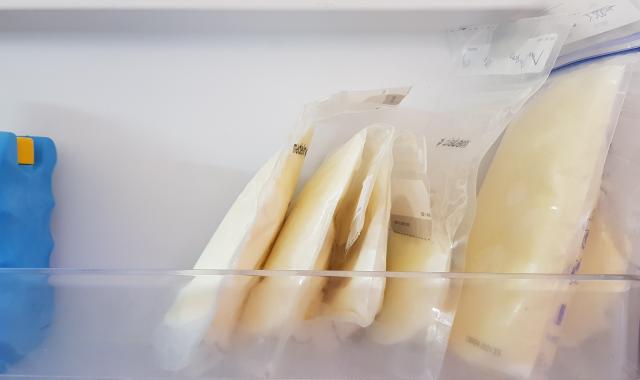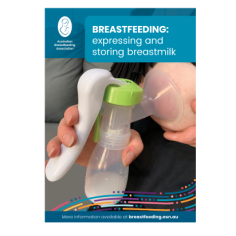There are a number of options for storing your expressed breastmilk

Anything you store your expressed breastmilk in should be ‘food-grade’ and BPA-free:
plastic bags
baby-feeding bottles
plastic cups with tight-fitting lids
small glass jars.
If you have a premature or sick baby, ask the hospital staff about containers, as they may supply them. Talk to your doctor or midwife about any extra steps you should take when handling or storing your milk. Breastmilk is best supplied fresh daily for a sick baby.
Freezing breastmilk
Seal the container of expressed breastmilk (EBM) and clearly label with the date. Place the container in the coldest part of the freezer.
If you want to add freshly expressed breastmilk to some that is already chilled or frozen, you need to first cool it in the fridge. Add it, then put it straight back into the freezer or fridge.
The following are guidelines for storage of breastmilk.
Breastmilk storage guidelines
Breastmilk | Room temperature(26°C or lower) | Refrigerator(5°C or lower) | Freezer |
|---|---|---|---|
| Freshly expressed into container | 6 to 8 hours If refrigeration is available, store milk there | No more than 72 hours Store at the back, where it is coldest | 2 weeks in freezer compartment inside refrigerator (-15°C) 3 months in freezer section of refrigerator with separate door (-18°C) 6 to 12 months in deep freeze (-20°C*) |
| Previously frozen - thawed in refrigerator but not yet warmed | 4 hours or less (ie the next feeding) | Store in refrigerator 24 hours | Do not refreeze |
| Thawed outside refrigerator in warm water | For completion of feeding | Hold for 4 hours or until next feeding | Do not refreeze |
| Baby has begun feeding | Only for completion of feeding, then discard | Discard | Discard |
*Chest / upright manual defrost deep freezer that is opened infrequently and keeps temperature.
Reproduced with permission from the National Health and Medical Research Council (NHMRC) Infant Feeding Guidelines (2012).
Cool freshly expressed breastmilk in the fridge before adding it to other chilled or frozen expressed breastmilk.
Important safety information about storing expressed breastmilk
Breastmilk should not be frozen or heated more than once. Store, defrost and offer small amounts of EBM at a time to your baby to avoid wastage. Any EBM that your baby doesn't take at that time will need to be thrown away. If your baby needs more, prepare another small amount.
Transporting breastmilk
You may need to carry your EBM – between home and hospital, home and work, or home and your baby's carer. The weather and travel time will affect how you should transport your EBM.
If your breastmilk is freshly expressed (that is, it hasn't been frozen), it is safe for use for 6 to 8 hours when kept below room temperature (26°C or lower) or for 72 hours when stored in the refrigerator (5°C or lower).
In the cooler months or if you only live a short distance from your workplace, you may not need to do anything special while transporting it. Just remove your expressed breastmilk from one fridge and place in the next fridge or freezer as soon as you arrive.
If it's a warm day or you have a longer drive, you will need to keep your milk cool during travel. You can carry your breastmilk safely in an insulated container with a freezer pack inside. A small bottle will even fit inside a wide-mouthed vacuum flask, with ice added to keep it cool.
If the milk is frozen, don't let it defrost while being carried. If it does thaw, use it within 24 hours. It is not safe to refreeze the milk.
© Australian Breastfeeding Association April 2022
Read more about expressing and storing
Evidence-led info and practical tips from our Breastfeeding Information Series
Breastfeeding: expressing and storing breastmilk



